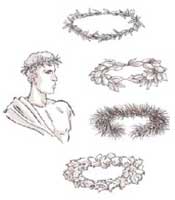奥运知识—橄榄枝棕榈叶松枝-古代奥运会奖品(在线收听)
At the modern Olympic Games, the first, second and third - placed athletes are rewarded, respectively, by gold, silver and bronze medals. At the Panhellenic Games, there was only one winner whose prize was a wreath or crown of leaves.
At each of the venues, the crowns were made with different types of leaves: - At Olympia, it was a wild olive leaf crown. At Delphi, a laurel crown. - At Corinth, a pine crown. - At Nemea, a wild celery crown.
As well as a crown, the winner received a red woollen ribbon, the taenia. A famous statue by the sculptor Polycletus (dating from the second half of the 5th century BC) shows a victor tying the ribbon around his head. The statue is called Diadurnenos and there is a bronze copy of it at the entrance to the Olympic Museum in Lausanne.
Finally, the winner often held a palm frond, another symbol of vicory.
重点词汇
Olympia, Delphi, Corinth, Nemea (古希腊地名)奥林匹亚,德尔菲,科林斯,尼米亚(它们都是泛希腊运动会的举办地,对冠军的奖励是不同的头冠)
Panhellenic a. (古代)泛希腊的 wreath n. 花圈, 花冠
venue n. 会议地点, 比赛地点 olive n. 橄榄树
laurel n. 月桂树 pine n. 松树
taenia n. 绑头部的带或绳 Lausanne n. 洛桑(瑞士城市)
palm n. 棕榈, (象征胜利的)棕榈叶 frond n. 叶
